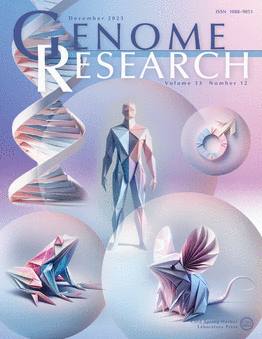H3K27 and H3K9 methylation mask potential CTCF binding sites to maintain 3D genome integrity
IF 5.5
2区 生物学
Q1 BIOCHEMISTRY & MOLECULAR BIOLOGY
引用次数: 0
Abstract
The three-dimensional (3D) genome structure is essential for gene regulation and various genomic functions. CTCF plays a key role in organizing Topologically Associated Domains (TADs) and promoter-enhancer loops, contributing to proper cell differentiation and development. Although CTCF binds the genome with high sequence specificity, its binding sites are dynamically regulated during development, and aberrant CTCF binding is linked to diseases such as cancer and neurological disorders, and aging. However, the mechanisms controlling CTCF binding remain unclear. Here, we investigate the role of repressive chromatin modifications in CTCF binding using H3K9 methyltransferase-deficient immortalized mouse embryonic fibroblasts (iMEFs) and H3K27 methyltransferase EZH1/2 inhibitor. We find that H3K9 and H3K27 methylation regulate CTCF binding at distinct genomic regions, and their simultaneous loss induces drastic changes in CTCF binding. These changes are associated with alterations in 3D genome architecture and gene expression, suggesting that repressive chromatin modifications preserve proper chromatin organization by preventing aberrant CTCF binding. Additionally, while CTCF binding sites repressed by H3K9 methylation are bound by CTCF in early mouse embryos, those repressed by both H3K9 and H3K27 methylation remain inaccessible, with early embryonic-specific H3K27 methylation forming at these sites. These findings implicate that H3K27 methylation plays a role for restricting CTCF binding in early embryos, ensuring proper genome organization during development.H3K27和H3K9甲基化掩盖潜在的CTCF结合位点,以维持三维基因组的完整性
三维基因组结构对基因调控和各种基因组功能至关重要。CTCF在组织拓扑相关结构域(TADs)和启动子-增强子环中起关键作用,有助于正常的细胞分化和发育。尽管CTCF以高序列特异性结合基因组,但其结合位点在发育过程中受到动态调节,CTCF异常结合与癌症、神经系统疾病和衰老等疾病有关。然而,控制CTCF结合的机制仍不清楚。在这里,我们使用H3K9甲基转移酶缺陷的永生化小鼠胚胎成纤维细胞(iMEFs)和H3K27甲基转移酶EZH1/2抑制剂研究了抑制染色质修饰在CTCF结合中的作用。我们发现H3K9和H3K27甲基化调节CTCF在不同基因组区域的结合,它们的同时缺失导致CTCF结合发生剧烈变化。这些变化与三维基因组结构和基因表达的改变有关,表明抑制性染色质修饰通过防止CTCF的异常结合来保持染色质的适当组织。此外,虽然被H3K9甲基化抑制的CTCF结合位点在早期小鼠胚胎中被CTCF结合,但那些被H3K9和H3K27甲基化抑制的位点仍然无法进入,早期胚胎特异性H3K27甲基化在这些位点形成。这些发现表明,H3K27甲基化在早期胚胎中限制CTCF结合,确保发育过程中适当的基因组组织。
本文章由计算机程序翻译,如有差异,请以英文原文为准。
求助全文
约1分钟内获得全文
求助全文
来源期刊

Genome research
生物-生化与分子生物学
CiteScore
12.40
自引率
1.40%
发文量
140
审稿时长
6 months
期刊介绍:
Launched in 1995, Genome Research is an international, continuously published, peer-reviewed journal that focuses on research that provides novel insights into the genome biology of all organisms, including advances in genomic medicine.
Among the topics considered by the journal are genome structure and function, comparative genomics, molecular evolution, genome-scale quantitative and population genetics, proteomics, epigenomics, and systems biology. The journal also features exciting gene discoveries and reports of cutting-edge computational biology and high-throughput methodologies.
New data in these areas are published as research papers, or methods and resource reports that provide novel information on technologies or tools that will be of interest to a broad readership. Complete data sets are presented electronically on the journal''s web site where appropriate. The journal also provides Reviews, Perspectives, and Insight/Outlook articles, which present commentary on the latest advances published both here and elsewhere, placing such progress in its broader biological context.
 求助内容:
求助内容: 应助结果提醒方式:
应助结果提醒方式:


